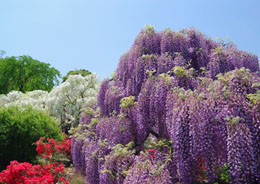Wisteria tree is a popularly grown landscaping plant species, highly appreciated for its showy and fragrant blossoms. Growing these trees is easy, as they are adaptable to a wide range of growing conditions and resistant to disease infestations.

Wisteria is a favorite flowering plant species among many gardening enthusiasts and hobbyists. It is actually a vine which can be trained into a tree habit. The globose tree head and long inflorescence add a unique aesthetic value to any landscape design. The increased demand of this tree species is credited to its extreme hardiness (drought tolerance and disease resistance), adaptability to different types of soil, and most importantly, breathtakingly attractive blooms in shades of pink, purple and blue. Among the various cultivars, the Chinese variety (
Wisteria sinensis) is most commonly planted.
Growing and Care
The wisteria tree is a summer-blooming tree. It is available in many nursery centers and gardening supply stores. Selecting a healthy sapling is an important step for maintaining this tree. Many times, nursery-sold wisteria plants are bare rooted―so make sure you purchase them from reputed nurseries.
Propagation
All wisteria varieties can be propagated from seeds, cuttings, and grafts. Nevertheless, most hobbyists opt for established saplings from nurseries to shorten the flowering period. Grafted wisteria grows and develops very fast, while blooming occurs within 4 years of plantation. Whichever propagation mode you choose, maintaining the tree is so simple that in some areas it is considered an invading plant species.
Planting Preparation
This tree grows best as a specimen tree in areas that receive at least six hours of daily sunlight. This flowering plant adapts well in a wide range of soil conditions, provided that the soil is well-drained and fertile. For planting the sapling, remove it gently from the packaging and expose it to the air. Then soak its base in water for 3-4 hours, prior to planting it in the soil. This allows re-hydration of the tree and promotes quick growth of new roots.
Growing the Tree
Dig the soil and make a plantation hole large and deep enough to place the root ball without damaging the roots. Ideally, the root crown should lie one inch below the top soil layer after planting. Accordingly, place the tree and fill the hole with soil, taking care that you do not disturb the fragile roots. Lightly press the soil around the plant, thereby making it firm. Water deeply.
Tree Care
During the first year, provide minimal irrigation of about one inch per week. Once established, this tree requires watering only during dry spells. As far as supplementation of fertilizers is concerned, minimal addition is sufficient to ensure timely flowering. Never supply a heavy dose of chemical additives, or the blooming will be hampered. If required, stake the tree and train it to grow in an upright manner.
Pruning
Pruning this tree is imperative to promote timely flowering and production of maximum blooms. Yearly removal of the twigs will help maintain the crown in a proper shape. Other benefits of regular pruning are improving light penetration, increasing tree vigor, and controlling disease and pest infestations (to some extent). The ideal time to do so is before the arrival of frost, either in late summer or early fall.
With proper care and maintenance, this ornamental flowering tree will bear pendulous blossoms in late spring or mid summer. During this period, you will find the wisteria tree laden with drooping, fragrant flowers.






 Wisteria is a favorite flowering plant species among many gardening enthusiasts and hobbyists. It is actually a vine which can be trained into a tree habit. The globose tree head and long inflorescence add a unique aesthetic value to any landscape design. The increased demand of this tree species is credited to its extreme hardiness (drought tolerance and disease resistance), adaptability to different types of soil, and most importantly, breathtakingly attractive blooms in shades of pink, purple and blue. Among the various cultivars, the Chinese variety (Wisteria sinensis) is most commonly planted.
Wisteria is a favorite flowering plant species among many gardening enthusiasts and hobbyists. It is actually a vine which can be trained into a tree habit. The globose tree head and long inflorescence add a unique aesthetic value to any landscape design. The increased demand of this tree species is credited to its extreme hardiness (drought tolerance and disease resistance), adaptability to different types of soil, and most importantly, breathtakingly attractive blooms in shades of pink, purple and blue. Among the various cultivars, the Chinese variety (Wisteria sinensis) is most commonly planted.